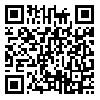BibTeX | RIS | EndNote | Medlars | ProCite | Reference Manager | RefWorks
Send citation to:
URL: http://tumj.tums.ac.ir/article-1-105-en.html
Background: Anosmia is a physical sign in post-traumatic patients, which significantly reduces the quality of life. Anosmia occurs in up to 30% of cases with head trauma. In this study we aimed to compare the Olfactory Bulb Volume (OBV) in patients with posttraumatic anosmia in different impact positions and also with healthy individuals to find the relation between the two variables.
Methods: Thirty-eight patients with posttraumatic anosmia and 27 healthy individuals with normal olfactory function were recruited in this case-control study performed in Amir Alam Hospital in Tehran, Iran. Variables of age, sex, time of trauma, site of trauma (frontoparietal/occipital), side of trauma, OBV, the results of olfactory identification tests and olfactory threshold were extracted and evaluated. We used non-contrasted 1.5-Tesla coronal brain MRI for the measurement of OBV.
Results: There were no significant differences between cases and controls regarding sex and age. Olfactory bulb volume was significantly smaller in cases compared to the controls (P=0.004). Among the case group, OBV was smaller in anterior versus posterior head traumas (P=0.02). OBV was also smaller in ipsilateral rather than the contralateral side of trauma (P=0.01).
Conclusion: The direction of trauma had a significant effect on OBV and it was smaller in traumas to the anterior and also ipsilateral sides of the head. It seems that changes in OBV differ due to the direction of head trauma and it can be helpful in predicting the prognosis of posttraumatic anosmia. Further studies are required for more conclusive statements.
| Rights and permissions | |
 |
This work is licensed under a Creative Commons Attribution-NonCommercial 4.0 International License. |





